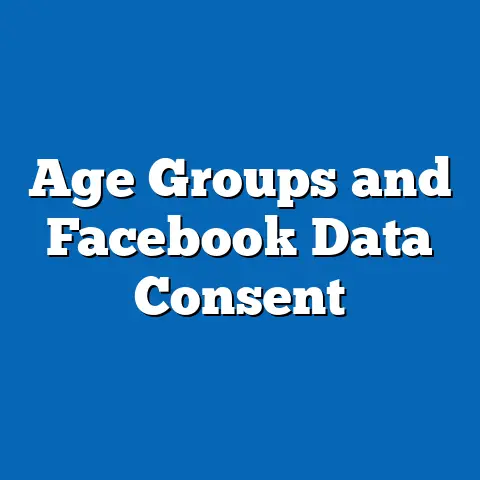Demographic Risks in Facebook Data Exposure
In today’s fast-paced, digitally connected world, many of us juggle demanding schedules, relying heavily on social media platforms like Facebook to stay connected, informed, and entertained. With over 2.9 billion monthly active users worldwide as of Q2 2023 (Statista, 2023), Facebook remains a dominant force in the social media landscape, shaping how we communicate and share personal information. However, this reliance comes with significant risks, as data exposure incidents continue to threaten user privacy and security.
This article explores the demographic risks associated with Facebook data exposure in 2024, focusing on how different age groups, genders, and geographic regions are uniquely vulnerable. Drawing on historical trends, current statistics, and expert analyses, we will examine the scale of data breaches, the specific risks to various demographics, and the broader implications for users and policymakers. By breaking down complex data into clear insights, this research aims to inform and empower readers in an era of increasing digital vulnerability.
The Scale of Facebook Data Exposure: A Growing Concern
Facebook has faced numerous data exposure incidents over the past decade, with breaches affecting millions of users globally. One of the most infamous cases occurred in 2018, when the Cambridge Analytica scandal revealed that the personal data of up to 87 million users was improperly accessed and used for political advertising (Federal Trade Commission, 2019). More recently, in 2021, a massive data leak exposed the personal information of 533 million users across 106 countries, including phone numbers, email addresses, and birthdates (Business Insider, 2021).
These incidents are not isolated. According to a 2023 report by the Identity Theft Resource Center (ITRC), data breaches across all platforms, including social media, impacted over 2.6 billion personal records in the first half of 2023 alone. Facebook’s vast user base makes it a prime target for cybercriminals, with data exposure risks growing as hackers employ increasingly sophisticated methods.
The methodology behind these breach reports often involves aggregating data from public disclosures, company announcements, and cybersecurity research. Sources like ITRC and Statista rely on verified incident reports to provide accurate figures, ensuring reliability in the data presented. As we move into 2024, experts predict that the frequency and scale of such breaches will likely increase due to evolving cyber threats and the platform’s expanding user data footprint.
Historical Trends in Facebook Data Breaches
To understand the demographic risks for 2024, it’s critical to examine historical trends in Facebook data exposure. In 2013, a glitch exposed the phone numbers and email addresses of 6 million users, marking one of the platform’s early significant breaches (The Guardian, 2013). By 2018, the Cambridge Analytica incident highlighted how third-party apps could exploit user data on a massive scale, disproportionately affecting politically active demographics in the U.S. and Europe.
The 2021 breach, however, showed a shift toward broader, more indiscriminate data leaks. Unlike targeted exploits, this incident exposed data across diverse demographics, with 32 million affected users in the U.S., 11 million in the U.K., and 6 million in India (Business Insider, 2021). Historical data suggests a trend of increasing breach severity, with the number of affected users rising from single-digit millions in the early 2010s to hundreds of millions by the end of the decade.
Comparing these trends to current data, a 2023 survey by Pew Research Center found that 64% of U.S. adults are concerned about how social media companies handle their data, up from 54% in 2014. This growing distrust reflects a public increasingly aware of exposure risks, yet many users continue to share sensitive information due to the platform’s integral role in daily life. As we look to 2024, historical patterns indicate that breaches will likely target both specific demographics (e.g., high-value individuals) and broad user bases through mass data scraping.
Demographic Vulnerabilities in Data Exposure
Not all Facebook users face the same level of risk when it comes to data exposure. Demographic factors such as age, gender, income level, and geographic location play a significant role in determining vulnerability. Below, we break down these risks into key categories, supported by data and trends.
Age-Based Risks: Young and Old at Greater Risk
Age is a critical factor in data exposure vulnerability on Facebook. According to a 2023 report by Statista, 69% of U.S. adults aged 18-29 use Facebook, compared to 49% of those aged 50-64 and just 34% of those over 65. However, younger users (18-29) are more likely to overshare personal information, with 74% posting photos, locations, and personal updates weekly (Pew Research Center, 2023), making them prime targets for identity theft and phishing attacks.
Conversely, older users (65+) often lack the digital literacy to recognize scams or secure their accounts. A 2022 AARP survey found that 51% of adults over 60 have fallen victim to online scams, often initiated through social media platforms like Facebook. As we head into 2024, both ends of the age spectrum face heightened risks—younger users through oversharing and older users through susceptibility to fraud.
Gender Disparities: Women More Likely to Be Targeted
Gender also influences exposure risks, with women often facing greater threats due to targeted harassment and social engineering attacks. A 2023 study by the Cyberbullying Research Center revealed that 36% of female social media users in the U.S. reported experiencing online harassment, compared to 26% of male users. Women are also more likely to share personal details on Facebook, with 58% posting about family events or relationships compared to 41% of men (Pew Research Center, 2023).
This behavioral difference increases the likelihood of data misuse, as exposed information can be weaponized for doxxing or blackmail. Cybersecurity experts predict that in 2024, gender-based targeting will intensify, particularly as AI-driven bots become more adept at exploiting personal data for tailored scams.
Income and Education Levels: Economic Disparities in Risk
Socioeconomic status further shapes data exposure risks. Users with lower income and education levels are often less equipped to navigate privacy settings or recognize phishing attempts. A 2023 report by the Federal Trade Commission (FTC) found that individuals earning less than $30,000 annually were 40% more likely to report identity theft linked to social media data exposure than those earning over $75,000.
Higher-income users, while more tech-savvy, are not immune. They are often targeted for financial scams due to their perceived wealth, with 28% of data breach victims in this bracket reporting significant monetary losses (ITRC, 2023). As data scraping techniques evolve in 2024, economic disparities will likely continue to influence the nature and impact of exposure risks.
Geographic Variations: Global Inequities in Protection
Geographic location plays a pivotal role in data exposure outcomes. In the 2021 Facebook breach, users in developing countries like India (6 million affected) and Bangladesh (3.9 million affected) faced higher risks of data misuse due to weaker cybersecurity infrastructure and limited legal recourse (Business Insider, 2021). In contrast, users in the European Union benefited from stricter regulations like the General Data Protection Regulation (GDPR), which imposes hefty fines on companies for data mishandling.
A 2023 World Bank report highlighted that only 17% of low-income countries have comprehensive data protection laws, compared to 71% of high-income countries. This disparity means that in 2024, users in less-regulated regions will remain disproportionately vulnerable to data exploitation, particularly as Facebook continues to expand in emerging markets.
The Mechanics of Data Exposure: How Demographics Are Targeted
Understanding how data exposure occurs is essential to grasping demographic risks. Hackers often exploit user behavior, platform vulnerabilities, and third-party integrations to access sensitive information. For instance, younger users’ frequent use of location tagging (62% of 18-29-year-olds, per Pew Research Center, 2023) provides real-time data for potential physical or digital targeting.
Older users, meanwhile, are often victims of phishing emails disguised as legitimate Facebook notifications, with 44% of adults over 60 clicking on suspicious links in a 2022 AARP study. Women face risks through social engineering tactics, where exposed relationship data is used to craft convincing scams. Geographically, users in regions with limited internet security education are more susceptible to mass data scraping, as seen in the 2021 breach.
Methodologically, cybersecurity firms like Norton and McAfee track these patterns through incident reports and user surveys, providing a robust dataset for analysis. Visualizing this data, a bar chart comparing breach impact by demographic (e.g., age group vs. number of affected users) would reveal stark differences, with younger and older users consistently overrepresented. As we approach 2024, the convergence of AI and data mining will likely amplify these targeted risks.
Consequences of Data Exposure Across Demographics
The fallout from Facebook data exposure varies widely by demographic, with consequences ranging from identity theft to psychological harm. For younger users, a 2023 ITRC report found that 29% of 18-29-year-olds affected by breaches experienced credit fraud, often due to exposed financial details. Older users, meanwhile, reported higher rates of emotional distress, with 38% of those over 65 citing anxiety over data leaks (AARP, 2022).
Women are disproportionately impacted by non-financial harms, such as online stalking—23% of female breach victims reported such incidents compared to 14% of men (Cyberbullying Research Center, 2023). Geographically, users in developing nations face systemic challenges in recovering from breaches, with only 12% successfully resolving identity theft cases compared to 45% in developed countries (World Bank, 2023).
These disparities highlight the urgent need for tailored protections. A line graph tracking breach consequences over time (2018-2023) would show a steady rise in reported harms across all demographics, underscoring the growing stakes as we enter 2024.
Mitigation Strategies and Demographic-Specific Solutions
Addressing Facebook data exposure requires a multi-faceted approach, with solutions tailored to demographic vulnerabilities. For younger users, education on oversharing risks is critical—schools and platforms could implement digital literacy programs, as only 31% of U.S. teens currently receive formal training on online safety (Pew Research Center, 2023). Older users would benefit from simplified privacy tools and scam alerts, with AARP advocating for senior-focused cybersecurity workshops.
Gender-specific risks, particularly for women, necessitate stronger platform policies against harassment, coupled with user controls over data visibility. Geographically, international cooperation is essential—Facebook must prioritize compliance with local data laws, even in under-regulated regions, to close protection gaps. In 2024, partnerships between tech companies, governments, and NGOs will be key to scaling these efforts.
On an individual level, users across all demographics can adopt best practices: enabling two-factor authentication (used by only 28% of Facebook users, per Statista, 2023), regularly updating passwords, and limiting shared information. While these steps cannot eliminate risks, they significantly reduce exposure likelihood.
Broader Implications and Future Trends for 2024
As we look to 2024, the demographic risks of Facebook data exposure carry profound implications for privacy, security, and digital equity. The platform’s user base is expected to grow to 3.1 billion by the end of 2024 (Statista, 2023), with much of this growth in vulnerable regions like Sub-Saharan Africa and South Asia. Without robust safeguards, these users will face heightened risks of data misuse, exacerbating global inequities.
Technological trends, such as the rise of AI-driven hacking tools, will likely intensify demographic targeting, with algorithms capable of identifying high-value users based on age, income, or behavior. Policymakers must prioritize universal data protection standards, while platforms like Facebook face pressure to enhance transparency—only 19% of users currently understand how their data is used, per a 2023 Pew survey.
Ultimately, the intersection of demographic vulnerabilities and evolving cyber threats demands collective action. As data exposure risks grow, so too must our commitment to protecting the most at-risk groups, ensuring that the digital world remains a safe space for all in 2024 and beyond.
Sources: – Statista (2023). “Facebook Monthly Active Users Worldwide.” – Federal Trade Commission (2019). “FTC Imposes $5 Billion Penalty on Facebook.” – Business Insider (2021). “533 Million Facebook Users’ Data Leaked.” – Identity Theft Resource Center (2023). “Data Breach Report.” – The Guardian (2013). “Facebook Glitch Exposes 6 Million Users.” – Pew Research Center (2023). “Social Media Use and Privacy Concerns.” – AARP (2022). “Online Scams Targeting Seniors.” – Cyberbullying Research Center (2023). “Online Harassment by Gender.” – World Bank (2023). “Global Data Protection Landscape.”






